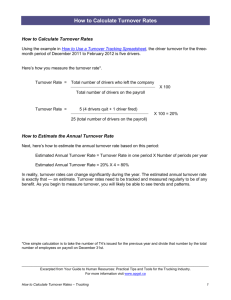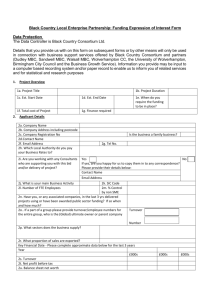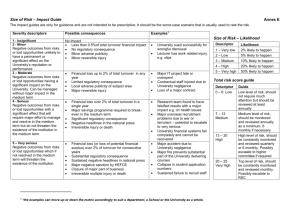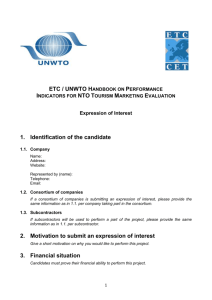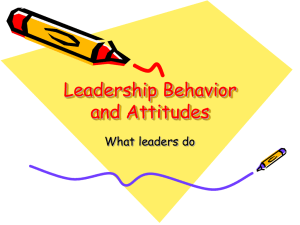Influence of Diversity on Conflicts, Turnover, and Performance
advertisement
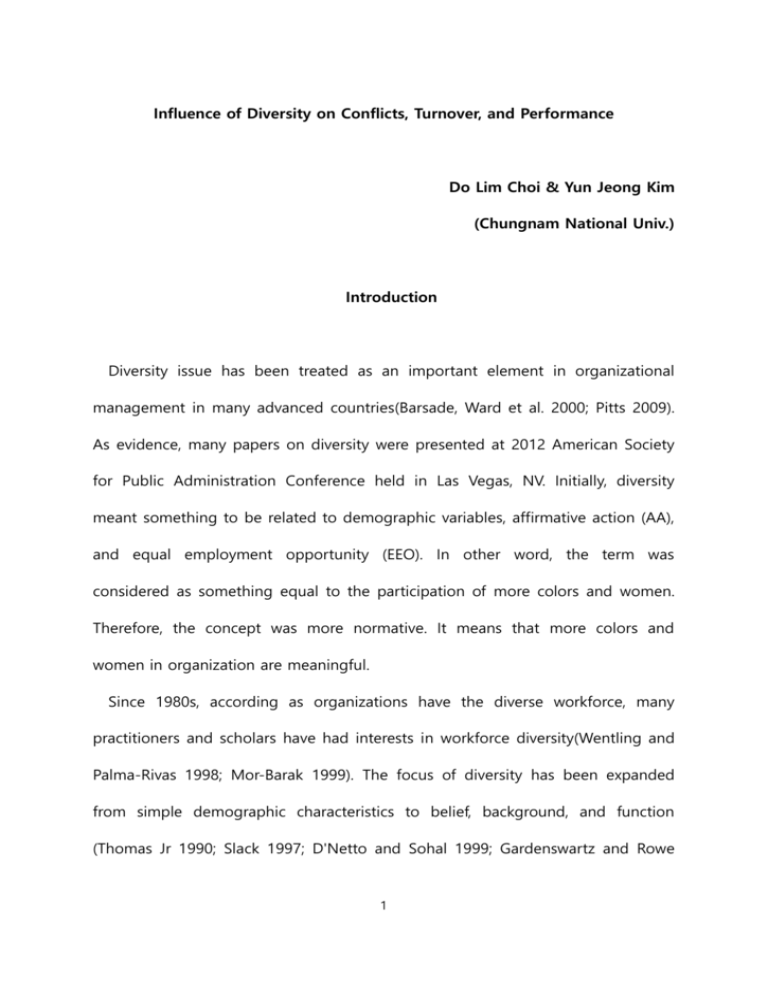
Influence of Diversity on Conflicts, Turnover, and Performance Do Lim Choi & Yun Jeong Kim (Chungnam National Univ.) Introduction Diversity issue has been treated as an important element in organizational management in many advanced countries(Barsade, Ward et al. 2000; Pitts 2009). As evidence, many papers on diversity were presented at 2012 American Society for Public Administration Conference held in Las Vegas, NV. Initially, diversity meant something to be related to demographic variables, affirmative action (AA), and equal employment opportunity (EEO). In other word, the term was considered as something equal to the participation of more colors and women. Therefore, the concept was more normative. It means that more colors and women in organization are meaningful. Since 1980s, according as organizations have the diverse workforce, many practitioners and scholars have had interests in workforce diversity(Wentling and Palma-Rivas 1998; Mor-Barak 1999). The focus of diversity has been expanded from simple demographic characteristics to belief, background, and function (Thomas Jr 1990; Slack 1997; D'Netto and Sohal 1999; Gardenswartz and Rowe 1 2010). Unlikely in the past, they would like to reveal the relationship between diversity and organizational performance(Pelled, Eisenhardt et al. 1999). It, however, is difficult to find empirical studies that examine the relationship between diversity and performance in the public sector, although there are some studies in the private sector(Pitts 2005; Pitts 2009). In the past decades, empirical studies have focused on direct relationship between demographic characteristic variables and performance, but recently a group of scholars tries to suggest more sophisticated model to explain diversity and performance. For example, conflict variable – emotional or task conflict – can be used as a moderate variable between diversity and performance(Pelled, Eisenhardt et al. 1999). The purpose of this study is to examine the relationships between diversity and conflicts, and performance. All three variables are classified into two dimensions. Diversity variable can be classified into indirectly work related and directly work related. Conflict variable is divided into two categories: emotional and task. Finally, performance is categorized into turnover and cognitive performance. This model is very similar to that of Pelled and her colleagues(1999). Theoretical Background and Hypotheses Diversity, Emotional Conflict, and Task Conflict 2 Organizations are consisted with employees who have various demographic characteristics. Employee composition in gender, age, race, education, tenure, functional background, and so on differs according to organizations. The diversity in demographic characteristics will influence emotional conflict. It can be explained by the term “categorization”, which is a very useful way to simplify and make our perceived organizations more predictable(Tajfel, Billig et al. 1971). Employees in organizations are categorized by demographic characteristics and categorization is a good means to explain people who belong to any group that shows the same demographic characteristic. Once categorization is formed, people try to describe the core characteristics of the group and try to compare with other groups. Categorization can be formed by gender, age, tenure, education, originality, race, functional background, and so on. This can be also explained by the model of inclusion and exclusion of Mor-Barak(1999). When categorizations interact, there is higher possibility that conflicts occur because they have different tendency in both thinking and acting. They will share different values, assumptions, and expectations according to categorization. Majority group tends to have negative attitudes, discrimination and prejudice, stereotyping, and racism to minority groups(Wentling and Palma-Rivas 1998). If diversity in demographic variables increases, individuals in workgroup have more chances to interact people who have different characteristics. It will cause any type of conflict in the process of interaction. As discussed above, each 3 categorization has its own unique values, assumptions, and expectations. Therefore, the more diverse categorization is the more conflicts happen. According to the demographic characteristics, different conflict can be stimulated in organization. Two types of conflict can be discussed: emotional and task conflict(Pelled 1996; Pelled, Eisenhardt et al. 1999). First, emotional or affective conflict means anger, resentment, and other negative feelings caused by the interaction of different social categories in the same workgroup. Among diversity variables, age, gender, originality, and race will contribute to the forming of emotional conflict in process of interaction. For example, young generation will show different way of thinking from old generation. Likewise, man and woman will put emphasis on different values(Gilligan 1982). As a result, when they confront in the process of work, negative feelings will be produced. Hypothesis1: Diversity in gender, age, and originality will have stronger positive associations with emotional conflict. Second is task or substantive conflict, which is more related to work than to emotion. Other demographic characteristics will bring more task conflict than emotional conflict. Task conflict means conflicts occurring due to different ideas, different ways to do work, or different work experience(Carrell and Mann 1995). For example, functional background is more associated with task conflict. 4 According to employees, experiences that they have had will be different. There are some employees who experience just a few functional departments and others who experience various functional departments. They may have different belief structures or way of thinking mechanism. When employees who have different functional background get together to decide what to do, they may spend more time to reach an agreement than those who have the same or similar functional background. Also, education will have similar effect on conflict. Different education level among employees will bring different ideas or suggestions in work. It will cause work related conflict. Hypothesis2: Diversity in education, tenure in organization, and functional background will have stronger positive associations with task conflict. Tenure in workgroup means the term that employees have worked in the current workgroup. Employees who work for longer term in the same workgroup will form and share similar values, beliefs, and expectations. They will more easily accept different categories. As a result, emotional conflict will be weakened(O'Reilly, Caldwell et al. 1989). Likewise, the negative effect of diversity in education, tenure in organization, and functional background on task conflict will be weakened, as tenure in the same workgroup increases. Employees who have worked in the same workgroup have more chances to learn from one 5 another. Therefore, conflict relevant to task will decrease. Hypothesis3: Group longevity will diminish the positive associations between diversity variables and conflict in work groups. Emotional and Task Conflict as Mediators: Links to Turnover Turnover means rate that employees leave their organization. Without having other alternatives, leaving current organization is not easy, because they need job to live or support their families. In order to measure the rate of turnover, employees’ opinion, whether they have any intention to leave or not, has been asked in many previous empirical studies. Emotional conflict caused by diversity will increase turnover. Because emotional conflict is relevant to anger, being isolated, and hatred, employees who feel emotional conflict in current organization will have turnover intention. In contrast to emotional conflict, task conflict caused by diversity will not be significantly associated with turnover intention. Task conflict is not based on category bias, prejudice, or personal negative feeling. Hypothesis4: Emotional conflict will be positively associated with turnover intention. Hypothesis5: Task conflict will not be a significant variable to influence 6 turnover intention. Task and Emotional Conflict as Mediators: Links to Performance Performance has been interpreted as a term to have various meanings. It may be interchangeably used with productivity, efficiency, consequence, result, effectiveness, output, outcome, and so on. Simply, performance implies consequences or results that organizations or employees accomplish in a certain time period. Performance can be measured in two ways. First, it can be measured by the secondary data. Through real numbers, goal achievement, efficiency, output, and so on can be evaluated. Second, it can be measured by employees’ cognitive judgment. In other words, performance level can be asked to employees. For examples, following questions can be employed to measure organizational performance. How much productive is it? How much efficient is it? Task conflict is able to be evaluated as a process seeking better alternatives or making better decisions to achieve organizational goals. Therefore, generally speaking, task conflict is necessary to improve organizational performance. However, emotional conflict will not be a significant variable to explain organizational performance in organization. Rather, it may play a role to decrease organizational performance. 7 Hypothesis6: Task conflict will be positively associated with performance. Hypothesis7: Emotional conflict will decrease organizational performance. Methodology Research Framework Research framework will be briefly explained here, although it is done in theoretical background in details. As in Figure 1, three dimensions are identified: independent, mediator, and dependent variables. First, there are two types of diversity variables: indirectly job related and directly job related variables. The former includes gender, age, and originality, the latter includes functional background, tenure, and education. Second, there are two types of conflict variables: emotional and task conflicts. Third, turnover and cognitive performance are used as dependent variables. Less Task Related Variables: Emotional Gender, Age, Originality Conflict Turnover Longevity More Task Related Variables: Functional Background. Task Conflict Education, Tenure 8 Performance <Figure 1> Research Framework In the relationship between diversity and conflict, diversity variables that are not directly related to task will be positively associated with emotional conflict. Diversity variables directly related to task will be positively associated with task conflict. And longevity will alleviate the effect of diversity variables on conflict variables. In the relationship between conflict and performance, emotional conflict will be negatively associated with employees’ turnover and task conflict will be positively associated with cognitive performance. And emotional conflict will have negative effect to performance and task conflict will also have negative effect to employees’ turnover. Measurement and Research Methods Initially, it was planned to ask direct values on diversity, but public servants felt uncomfortable with it. They seemed to worry that somebody might know about who is who. Also, they didn’t know about exact information on colleagues’ age, tenure, and educational institution that coworkers graduate. Many respondents in pilot study didn’t answer to questions such as final educational institution, their hometown, age, and so on. So, instead of asking direct information or values, the degree of diversity was asked. For example, what is the level of diversity in age? Each question has five point Likert scale. 9 To test hypotheses suggested in this paper, a few quantitative analysis methods were implemented. For basic analyses, frequency, mean, and correlation analysis were implemented. And for hypothesis test, regression and path analysis were employed. Findings Basic Statistics This section reports basic information and statistics for further research such as response rate, demographic characteristics, and Cronbach alpha. Response Rate A metropolitan city was selected for this research and respondents are those who are working in the metropolitan city hall. Total 172 questionnaires were distributed in March 2012 and 152 collected. It showed a response rate of 88.4%. All questionnaires collected were used in final analysis. Descriptive Statistics Detailed descriptive statistics are reported in Table 1. As shown in Table 1, 68.4 percent of the respondents were male and 31.6 percent female. Most of the employees were in the 40s (62.5%). Regarding education, 61.8 percent were university graduates and 21.7 percent had graduate degrees. Of the respondents, 10 46.6 percent had worked for 11 to 20 years and 37.7 percent for 21 to 30 years. In functional background, most of respondents (82.1%) had experienced less than 11 work types. Finally, most of respondents were from Daejeon(44.3%) and Chungnam(30.9%). <Table 1> Demographic Characteristics Classification Gender Age Education Work years Frequency(total no.: 152)* Number Percentage Male 104 68.4 Female 48 31.6 20s 1 0.6 30s 20 13.2 40s 95 62.5 Older than 50 36 23.7 High school 15 9.9 Community college 10 6.6 University 94 61.8 Graduate school 33 21.7 1 to 10 years 13 8.9 11 to 20 years 68 46.6 21 to 30 years 55 37.7 11 More than 30 years 10 6.8 Functional Less than 6 64 47.8 background 6 to 10 46 34.3 11 to 15 11 8.2 16 to 20 7 5.2 More than 20 6 4.5 Daejeon 66 44.3 Chungnam 46 30.9 Chungbuk 20 13.4 others 17 11.6 Originality *: Each demographic characteristic may have a frequency missing which indicates the number of respondents that did not mark that question. Credibility and Correlation Table 2shows means, standard deviation, Cronbach alph, and correlation coefficients. Through this table, one can obtain basic information about the thoughts of respondents for main variables and to a degree guess the results. A Cronbach alpha was used to measure the ‘unidimensionality’ of multiple questions. All variables show reliability coefficients of 0.7 or higher which confirms the unidimensionality of variables. Among four questions to measure emotional conflict, one question was removed, because respondents didn’t recognize it as the same dimension. 12 Regarding correlation, all variables are statistically significant with each other. Emotional conflict variable is negatively correlated with task conflict and performance and positively with turnover. Task conflict variable is negatively correlated with turnover and positively with performance. Finally, turnover variable is negatively correlated with performance. <Table 2> Means, Standard Deviation, Credibility, and Correlation (n=152) Correlation coefficient Variables Mean Std. Emotional Task α Turnover Performance Emotional 1.0 2.15 0.70 0.7 3.90 0.72 0.7 2.96 0.90 0.8 3.77 0.72 0.7 conflict Task conflict -0.57*** 1.0 Turnover 0.27*** -0.19** 1.0 Performance -0.49*** 0.71*** -0.22*** **: significant at 0.05 1.0 ***: significant at 0.01 Respondents recognize that task conflict is higher than emotional conflict. Almost half of respondents have thought of turnover and they have positive mind toward their performance. Hypothesis Test 13 Less work-related variables and emotional conflict Hypothesis1: Diversity in gender, age, and originality will have stronger positive associations with emotional conflict. As shown in table 3, gender and originality diversity variables were associated with emotional conflict, but in the opposite direction. Gender diversity was a significant variable to increase emotional conflict, but originality diversity was negatively associated with emotional conflict. Maybe, the samples of this study are inappropriate to measure the effect of originality diversity, because most of respondents are from Daejeon(44.3%) and Chungchung Province(44.3%). Further research will be necessary in the future. And age diversity was not a variable to influence emotional conflict. Thus, hypothesis 1 would be partially accepted. <Table 3> Relationships between less work-related variables and emotional conflict Independent variables Dependent variable: Emotional conflict Beta Standard error t Gender diversity .16730 .30538 2.04** Age diversity -.06301 .07082 -.78 Originality diversity -.23185 .06653 -2.86*** F Value: 5.20 R-Square: 0.0977 **: significant at 0.05 ***: significant at 0.01 14 Adj R-Square: 0.0789 More work-related variables and task conflict Hypothesis2: Diversity in education, tenure in organization, and functional background will have stronger positive associations with task conflict. As shown in table 4, functional background diversity and tenure diversity in public service were statistically associated with task conflict. Both variables are positively associated. It means that task conflict increases when employees have diverse functional background experience. Also, task conflict increases when employees have diverse tenure. And educational diversity was not a variable to affect task conflict. Thus, hypothesis 2 would be partially accepted. <Table 4> Relationships between more work-related variables and task conflict Independent variables Dependent variable: Task conflict Beta Standard error t Educational diversity .01933 .36497 .24 Functional background diversity .20855 .07079 2.51** Tenure diversity in public service .18106 .08127 2.15** F Value: 5.28 R-Square: 0.1004 Adj R-Square: 0.0814 **: significant at 0.05 ***: significant at 0.01 Effect on group longevity between diversity variables and conflicts 15 Hypothesis3: Group longevity will diminish the positive associations between diversity variables and conflicts in work groups. Group longevity was not a significant variable to mediate the relationships between diversity variables and conflicts in work groups. In another word, there was no difference in the relationships between diversity variables and conflicts according to group longevity. Relationship between conflicts and turnover Hypothesis4: Emotional conflict will be positively associated with turnover intention. Hypothesis5: Task conflict will not be a significant variable to influence turnover intention. As shown in table 5, emotional conflict was positively associated with turnover intention. It means that employees have intention to leave current organization when they feel more emotional conflict. Thus, hypothesis 4 would be accepted. Task conflict was not a significant variable to influence turnover intention. Thus, hypothesis 5 would also be accepted. <Table 5> Relationships between emotional conflict and performance Independent variables Dependent variable: Turnover Beta 16 Standard error t Emotional conflict .23721 .12691 2.44** Task conflict -.05803 .12233 -0.60 F Value: 5.81 R-Square: 0.0751 Adj R-Square: 0.0622 **: significant at 0.05 Relationship between conflicts and performance Hypothesis6: Task conflict will be positively associated with performance. Hypothesis7: Emotional conflict will decrease organizational performance. As shown in table 6, both emotional and task conflict were statistically associated with performance variable, but in the opposite direction. Like in hypothesis 6, the higher task conflict is, the greater organizational performance is. On the contrary, the higher emotional conflict is, the lower organizational performance is. Thus, hypothesis 6 and 7 would be accepted. <Table 6> Relationships between emotional conflict and performance Independent variables Dependent variable: Performance Beta Standard error t Emotional conflict -.16174 .07293 -2.29** Task conflict .61428 .07040 8.71*** F Value: 5.81 R-Square: 0.0751 **: significant at 0.05 ***: significant at 0.01 17 Adj R-Square: 0.0622 Implications and Conclusion In two aspects, the usefulness of this study can be explained: theoretical and practical. First is a theoretical aspect. This research is the primary study in Korea, especially in the public sector. This will be a starting point to discuss about the effect of diversity variables on various result variables. Second is a practical aspect. First, organizations should start to consider gender composition as a variable to affect conflict, satisfaction, and performance. It doesn’t mean that there is the best composition in gender. Because gender composition causes emotional conflict, organizations or leaders ought to make more efforts to reduce the level of conflict. Second, emotional conflict is a variable to explain the opinion toward turnover. Organizations should pay more attention to workgroups that have a few females with most males. Third, task conflict is helpful to increase organizational performance, so organizations should try to maintain the appropriate level of task conflict in workgroups considering various function experience and tenure in public service. Fourth, emotional conflict is harmful for organizational performance. 18 References Barsade, S. G., A. J. Ward, et al. (2000). "To Your Heart's Content: A Model of Affective Diversity in Top Management Teams." Administrative Science Quarterly 45(4): 802-836. Carrell, M. R. and E. E. Mann (1995). "Defining Workforce Diversity in Public Sector Organizations." Public Personnel Management 24(1): 99-112. D'Netto, B. and A. S. Sohal (1999). "Human resource practices and workforce diversity: an empirical assessment." International journal of Manpower. MCB university Press 20(8): 530-547. Gardenswartz, L. and A. Rowe (2010). Managing Diversity: A Complete Desk Reference & Planning Guide. SHRM, Society For Human Resource. Gilligan, C. (1982). "In a Different Voice: Psychological Theory and Women's Development." Harvard University Press. Mor-Barak, M. E. (1999). "Beyond Affirmative Action: Toward a Model of Diversity and Organizational Inclusion." Administration in Social Work 23(3-4): 47-68. O'Reilly, C. A., D. F. Caldwell, et al. (1989). "Work Group Demography, Social Integration, and Turnover." Administrative Science Quarterly 34(1): 21-37. Pelled, L. H. (1996). "Demographic Diversity, Conflict, and Work Group Outcomes: An Intervening Process Theory." Organization Science 7(6): 615-631. Pelled, L. H., K. M. Eisenhardt, et al. (1999). "Exploring the Black Box: An Analysis of Work Group Diversity, Conflict, and Performance." Administrative Science Quarterly 44(1): 1-28. Pitts, D. W. (2005). "Diversity, Representation, and Performance: Evidence about Race and Ethnicity in Public Organizations." Journal of Public Administration Research and Theory 15(4): 615-631. Pitts, D. W. (2009). "Diversity Management, Job Satisfaction, and Performance: Evidence from U.S. Federal Agencies." Public Administration Review 69(2): 328-338. 19 Slack, J. D. (1997). "FROM AFFIRMATIVE ACTION TO FULL SPECTRUM DIVERSITY IN THE AMERICAN WORKPLACE: SHIFTING THE ORGANIZATIONAL PARADIGM." Review of Public Personnel Administration. 17(4): 75-87. Tajfel, H., M. G. Billig, et al. (1971). "Social categorization and intergroup behavior." European Journal of Social Psychology 1: 149-177. Thomas Jr, R. R. (1990). "From Affirmative Action to Affirming Diversity." Harvard Business Review 68(2): 107-117. Wentling, R. M. and N. Palma-Rivas (1998). "Current status and future trends of diversity initiatives in the workplace: Diversity Development Quarterly 9(3): 235-253. 20 experts' perspective." Human Resource


